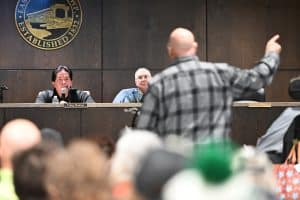Will Sommer’s Trust the Plan: The Rise of QAnon and the Conspiracy That Unhinged America, is a detailed and deeply disturbing study of what is essentially a cult of belief deeply rooted in our society, politics, and public policy. Although QAnon defies a simple explanation, it does contain some basic features. Advocates believe that there is a cabal controlled by shadowy forces within the government, which runs most of both political parties, intelligence agencies, and portions of the U.S. military. These forces are not in complete control of all power, however. To the QAnon believer, they are just one side of a civil war from within the country. On the side of righteousness is “Q,” a figure who leaves online hints to his followers. Some believe Q might be Donald Trump, who will oversee the mass arrest of traitors with military assistance. (25) Other participants in QAnon see Trump as America’s savior that Q will someday restore to power. They refer to Trump as their “dream candidate,” what some Q believers called “GEOTUS” or “God Emperor of the United States.” (23)
Trump is not the only celebrity populating the QAnon landscape. Within the alleged cabal are a host of well-known figures such as George Soros and Hillary Clinton, Chrissy Teigen, and even Tom Hanks. Collectively, these individuals represent an ongoing existential threat not only to America’s government, but also its collective soul. Apparently, Soros, Clinton, Hanks and many others are Satanic, blood drinking pedophiles engaged in trafficking in children so that they can extract adrenochrome, an extract that use to combat aging. (2) As Sommer notes: “Anons see the world as an abattoir, a place where innocent children are sexually tortured to keep Hollywood celebrities wrinkle-free.” (132) The author, and a variety of journalists and scholars have rightly pointed out that QAnon can trace its beliefs back more than a century to the anti-Semitic tract The Protocols of the Elders of Zion.
One of the most worrisome features of QAnon is its consistent embrace of violence. (135) Overlaying the movement is an ongoing desire for “a violent, cathartic moment called ‘The Storm.’” (5) Sommer states early in the book that: “Q’s followers have responded to modern life by retreating into a violent fantasy that exists parallel to the real world.” (5) In reality, they are ready to act on their fantasy. This was apparent during the January 6th riot, but it is part of a more consistent record. Public officials across the spectrum, from Anthony Fauci to local school board members are subject to death threats. Romana Didulo, the self-proclaimed “queen” of Canada, has called on her supporters to “Shoot to kill anyone who tries to inject Children under the age of 19 years old with Coronavirus vaccines/bioweapons or any other Vaccines.” (202) Sommer himself has been repeatedly threatened on social media: “Hopefully one day you die via mass shooting or pressure cooker bomb.” (43)
In many cases, as the author points out, QAnon is a grift. A Louisiana engineer by the name of Harvey Barnard came up with something called the National Economic Stabilization and Recovery Act (NESARA), which offered the utopian vision of a world without credit card, mortgage, or any other debt. It is now a core QAnon principle. (108) An individual named Field McConnell adapted NESARA to promote a crypto currency scheme based around Zimbabwean currency—otherwise known as the “Zim”—that he argues will skyrocket in value once the global financial “reset” is done. (138) Hundreds of people have been bilked out of tens of thousands of dollars over frauds like these.
READ: Can Education Solve Our Country’s Conspiracy Theory Problem?
Who exactly joins QAnon? Sommer and many other authors point to the fact that QAnon is not only part of the political or social fringe. Without question, white nationalists and cranks are present – more generally, QAnon appeals to people who feel “dislocated in the modern world.” (197) Today, you can find believers within the natural parenting community, self-help gatherings, and yoga groups. According to a February 2021 American Enterprise Institute poll, 15 percent of Americans agreed with the statement: “Donald Trump has been secretly fighting a group of child sex traffickers that include prominent Democrats and Hollywood elites.” That is approximately 50 million Americans.
QAnon adherents persist in their beliefs even though they are constantly proven wrong. Early predictions about October 30, 2017, being the day of Hillary Clinton’s arrest never came to be. Despite the January 6th riots, Joe Biden became president. Donald Trump has yet to be reinstated more than two years later.
Why then does QAnon continue? Part of the explanation comes for the structure of the movement itself. At its core, QAnon is an interactive experience, as advocates can follow “breadcrumbs” online and add to the discussion with their own research. In October 2020, Wired magazine noted that the whole process resembled an “alternate reality game” (ARG):
ARGs are designed to be clue-cracking, multiplatform scavenger hunts. They’re often used as a promotion, like for a movie. A studio plants a cryptic clue in the world around us. If you notice it and Google it, it leads to hundreds more clues that the game maker has craftily embedded in various websites, online videos, maps, and even voice message boxes.
As Sommer notes, true QAnon believers can take this practice further, gaining fame within the community by tracking down and posting a constant stream of new revelations, becoming internet celebrities in the process. (46)
How can we combat what Sommer describes as an “enormous radicalization machine”? (57) Facebook, Twitter, Reddit, and YouTube are among many platforms that have struggled to keep pace with QAnon misinformation. In fact, their own algorithms have sometimes inadvertently promoted conspiracy theories.
Some remedies, as Alex Jones has repeatedly discovered, are legal. Multimillion dollar judgements may have a chilling effect on some QAnon advocates. However, as the author points out, the U.S. legal system has only slowly adapted to the many instances of online harassment conducted by QAnon followers. Few victims of QAnon campaigns have the time or financial resources to withstand years of protracted legal battles.
A final potential solution may be therapeutic. Contemporary QAnon conspiracy belief recalls discussion about cults and deprogramming more than 50 years ago. Direct confrontation will likely backfire and provoke the QAnon believer to dig in their heels. Sommer counsels patience and persistence, something that is difficult considering the concrete, documented threats posed by many people in the movement.
Taken as a whole, Trust the Plan, is a shocking, disturbing, and necessary read. As much as we might want to dismiss QAnon for its strangeness and absurdity, it is ingrained in too many parts of America to ignore.
Teachers, voters, and citizens need to take note.







